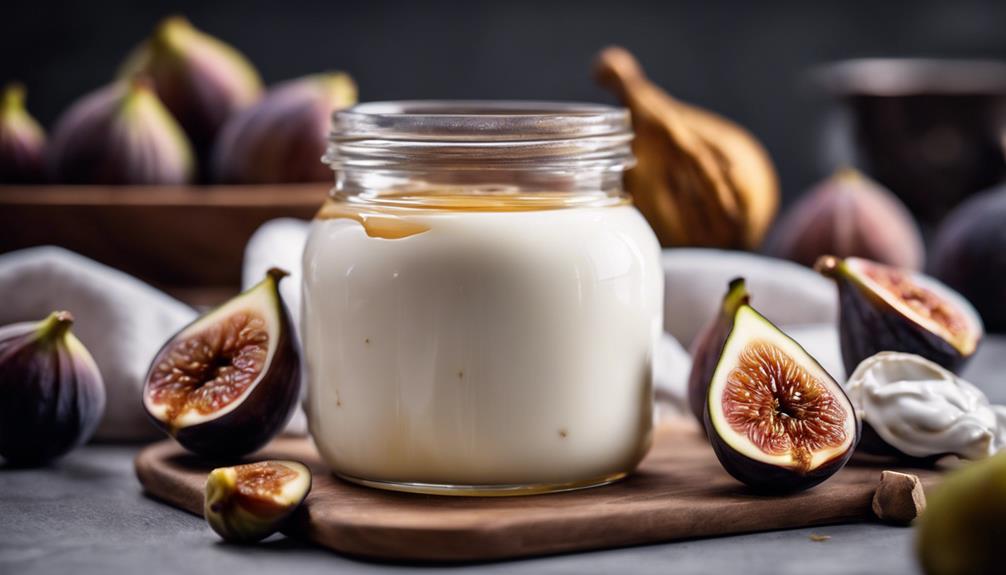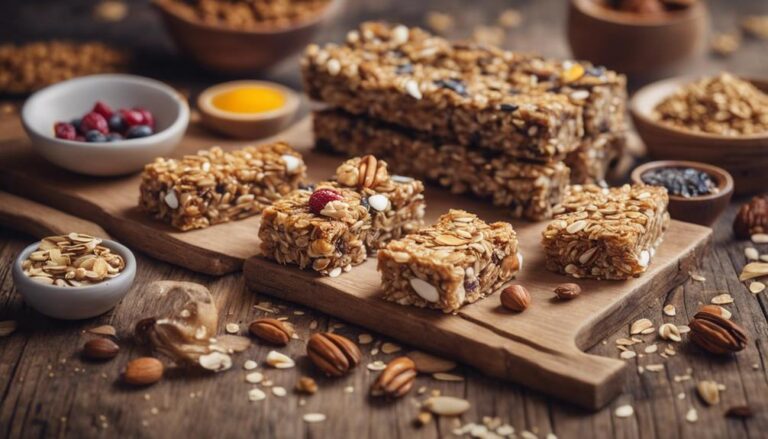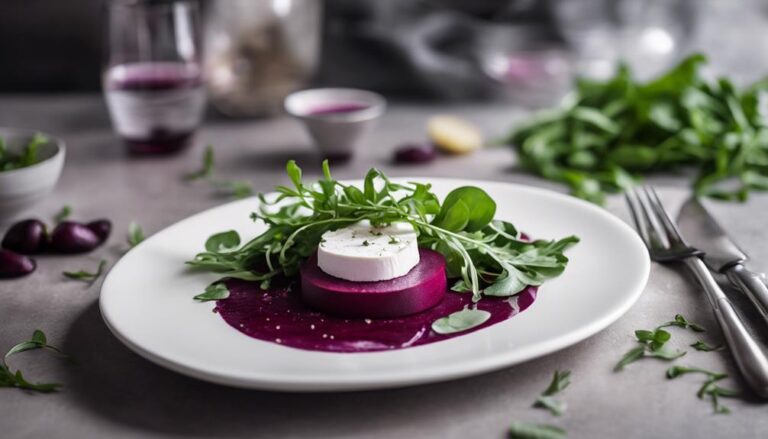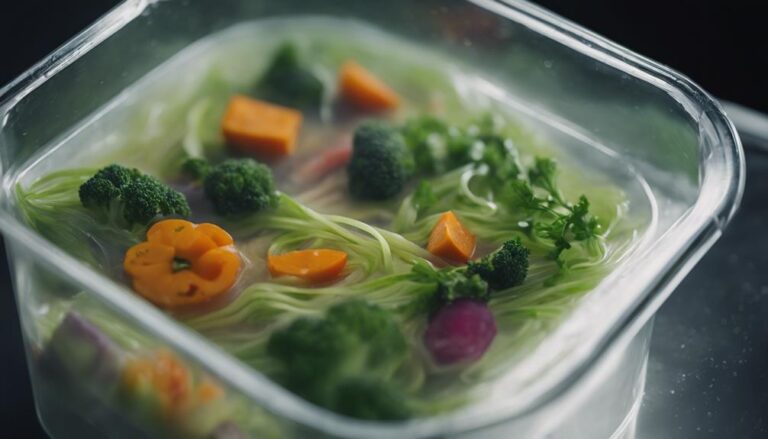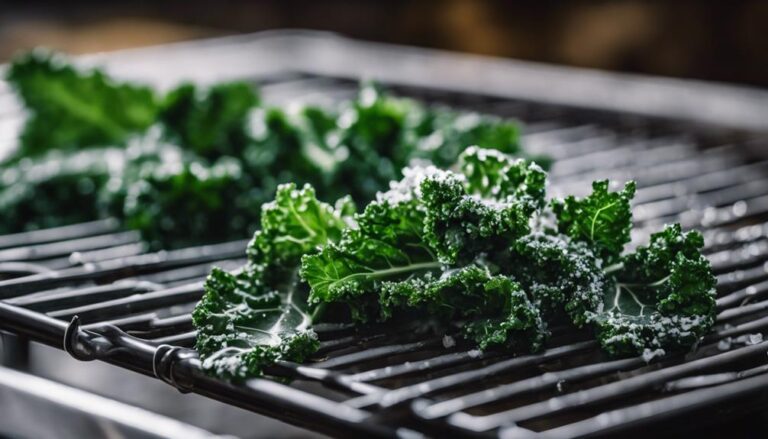Sous Vide Greek Yogurt With Honeyed Figs
To explore 'Sous Vide Greek Yogurt With Honeyed Figs,' start by preparing a rich, velvety Greek yogurt base using traditional straining techniques for a creamy texture and high protein content. Incorporate live active cultures into quality milk and maintain an even incubation temperature. Once the yogurt is ready, infuse the sweetness of honeyed figs using precise sous vide methods to elevate the flavor profile. This process results in a luxurious treat combining the tang of Greek yogurt with the natural sweetness of figs. Ready to explore further into the art of Greek yogurt-making and sous vide cooking techniques?
What You Will Learn Here
- Sous vide method for precise temperature control
- Infusing flavors into yogurt for enhanced taste
- Honeyed figs for sweet and fruity contrast
- Creamy Greek yogurt texture from sous vide
- Perfect balance of flavors with this method
Yogurt-Making Techniques in Greece
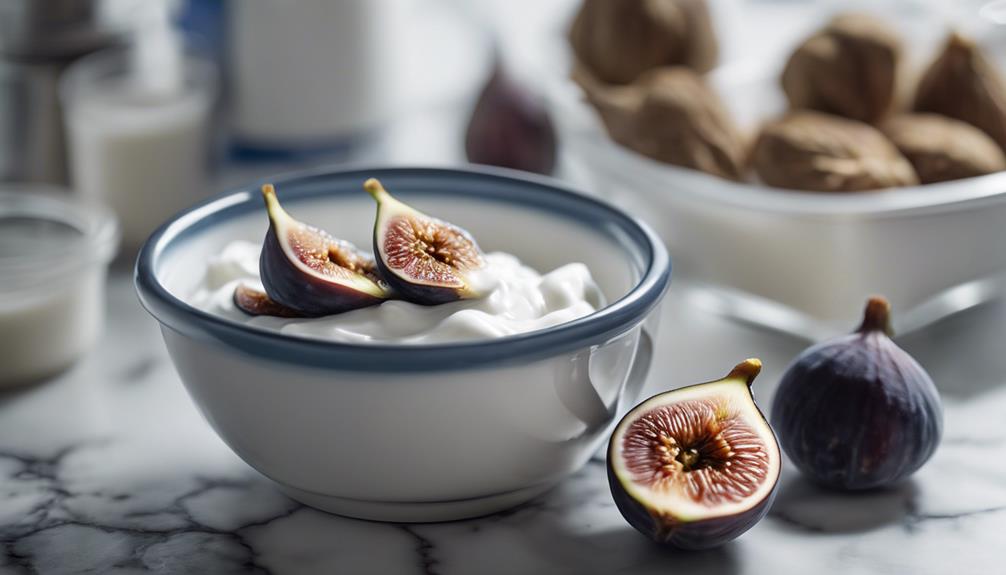
When it comes to yogurt-making techniques in Greece, it's important to understand the rich history behind this creamy delight.
Traditional fermentation methods play a significant role in crafting the unique texture and tangy flavor of Greek yogurt.
Local Greek ingredients, like fresh milk and culture strains, contribute to the authenticity and quality of this beloved dairy product.
Greek Yogurt History
Greek yogurt, known for its rich and creamy texture, has a long history in Greece, where traditional yogurt-making techniques have been preserved for centuries. Greek yogurt production involves straining out whey, resulting in a thicker consistency compared to regular yogurt. This straining process also contributes to Greek yogurt's higher protein content, making it a popular choice for those seeking a nutritious snack.
Yogurt health benefits have been recognized for ages, with Greek yogurt specifically known for its probiotic properties that promote gut health. The live cultures present in Greek yogurt aid in digestion and can boost the immune system. Additionally, the protein in Greek yogurt helps in muscle building and repair, making it a favorite among athletes and fitness enthusiasts.
The art of crafting Greek yogurt has been passed down through generations in Greece, with families often using heirloom starter cultures to ferment the milk. This dedication to tradition guarantees that the authentic flavors and textures of Greek yogurt remain intact, offering a taste of history in every spoonful.
Traditional Fermentation Methods
To understand the traditional fermentation methods used in Greece for crafting yogurt, consider the meticulous process of straining out whey to achieve the desired thick consistency and heightened protein content characteristic of Greek yogurt.
In Greece, yogurt-making has a rich history deeply rooted in traditional fermentation methods. The process often involves using specific strains of bacteria to ferment milk, creating the distinct tangy flavor and creamy texture that Greek yogurt is known for.
Unlike modern equipment commonly used in commercial yogurt production, traditional Greek methods often rely on simple tools like cheesecloth and clay pots to strain the yogurt and remove excess whey. This careful straining process is essential for achieving the thick and velvety texture that sets Greek yogurt apart.
Local Greek Ingredients
Embracing the bounty of local Greek ingredients enhances the authenticity and flavor profile of traditional yogurt-making techniques in Greece. Greek yogurt farms play an essential role in sourcing the high-quality milk needed for this creamy delight. These farms are often family-owned, passed down through generations, ensuring a deep connection to the land and animals.
Artisanal production techniques further elevate the yogurt-making process. Skilled artisans carefully heat the milk to just the right temperature, then introduce live cultures that ferment the milk into yogurt over several hours. This slow fermentation process is key to achieving the signature tangy taste and thick texture of Greek yogurt.
In Greece, the environment and resources contribute to the unique character of the yogurt. The rich grasses that the cows graze on impart a distinct flavor to the milk, enhancing the final product. By utilizing these local ingredients and techniques, Greek yogurt stands out as a beloved culinary treasure with deep roots in tradition and quality.
Key Yogurt-Making Components
When making yogurt, selecting the right type of milk is essential for achieving the desired consistency and flavor. Here are four key components to take into account when making yogurt:
- Type of Milk: Start with whole milk for a creamier yogurt or opt for low-fat milk for a lighter version. Avoid using ultra-pasteurized milk, as it may impact the fermentation process.
- Starter Culture: Choose a high-quality yogurt with live active cultures to kickstart the fermentation process. This will help introduce beneficial bacteria for probiotic benefits.
- Temperature Control: Maintain a consistent temperature during incubation, typically around 110°F (43°C), to allow the bacteria to thrive and create the desired texture.
- Straining Method: Decide whether to strain the yogurt to achieve a thicker consistency like Greek yogurt. Use cheesecloth or a fine mesh strainer for best results.
Greek Yogurt Creations
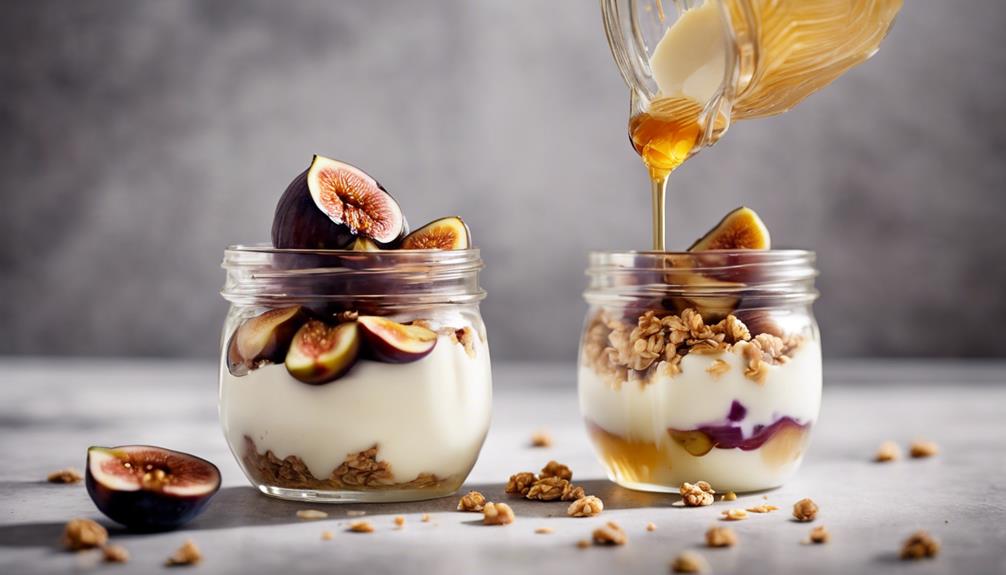
When it comes to Greek yogurt creations, there are endless possibilities to explore. From a delightful honeyed fig yogurt recipe to the rich blend of fig and almond yogurt, you have a wide array of flavors to experiment with.
Whether you prefer a sweet or nutty twist to your Greek yogurt, these creations offer a delicious way to enjoy this creamy treat.
Honeyed Fig Yogurt Recipe
To create a delicious Honeyed Fig Yogurt recipe, gather fresh figs, Greek yogurt, and honey as the main ingredients. Here are four steps to guide you through making this delightful treat:
- Prep the Figs:
Wash and slice the figs into small pieces, removing any stems. The figs will add a natural sweetness and a lovely texture to your yogurt.
- Mix with Greek Yogurt:
In a bowl, combine the Greek yogurt with the sliced figs. The creaminess of the yogurt pairs perfectly with the juicy figs.
- Drizzle with Honey:
Drizzle a generous amount of honey over the yogurt and fig mixture. The honey adds a rich sweetness that complements the flavors of the figs and yogurt.
- Chill and Serve:
Allow the Honeyed Fig Yogurt to chill in the fridge for a bit before serving. Enjoy this delightful combination as a healthy breakfast, a satisfying snack, or a sweet dessert idea.
Fig and Almond Yogurt
For a delightful twist on traditional Greek yogurt, elevate your culinary experience with the delectable combination of figs and almonds in this Fig and Almond Yogurt creation.
- Fig and Almond Pairing: The sweet, slightly nutty flavor of almonds complements the natural sweetness of figs, creating a harmonious blend of tastes in your yogurt.
- Yogurt Flavor Experimentation: Incorporating figs and almonds into your yogurt opens up a world of flavor experimentation, allowing you to customize your yogurt to suit your taste preferences.
- Nutritious Boost: Almonds are packed with healthy fats and figs are a great source of fiber, vitamins, and minerals, adding a nutritious boost to your yogurt.
- Textural Contrast: The crunchy texture of almonds contrasts beautifully with the softness of figs, providing a delightful textural experience in every spoonful of your Fig and Almond Yogurt.
Fig and Almond Yogurt
Exploring the fusion of figs and almonds in Greek yogurt elevates its flavor profile to new heights.
- Almond variations: Incorporating almond variations, such as sliced almonds, almond extract, or almond butter, into your Greek yogurt adds a nutty richness that complements the creamy texture of the yogurt.
- Fig toppings: Fresh fig slices or diced dried figs make excellent toppings for Greek yogurt. Their natural sweetness and slight crunch enhance the yogurt's taste and provide a delightful contrast in texture.
- Sweet and savory combinations: Experiment with combining fig preserves with almond yogurt for a delightful mix of sweet and savory flavors. The fig's natural sweetness pairs beautifully with the nuttiness of almonds, creating a harmonious blend in each spoonful.
- Fig preserves: Using fig preserves as a mix-in for your almond yogurt introduces a burst of fig flavor throughout the yogurt, providing a delicious twist to your traditional Greek yogurt experience.
Yogurt Straining Technique
When straining yogurt, you're aiming for creaminess in the final product. This process requires time and patience to achieve the desired consistency.
Additionally, straining yogurt results in a higher yield of whey, giving you a thicker end product.
Straining for Creaminess
To achieve a velvety texture in your Greek yogurt, consider employing the yogurt straining technique. Straining techniques play an important role in achieving that creamy consistency characteristic of Greek yogurt. By straining the yogurt, you remove excess whey, resulting in a thicker, richer texture that's perfect for various dishes or enjoying on its own.
There are different methods for straining yogurt, but one common approach is to use a fine mesh strainer or cheesecloth placed over a bowl. Simply pour the yogurt into the strainer, cover it, and let it sit in the refrigerator for several hours or overnight. As the whey drains out, the remaining yogurt thickens, giving it that desired creamy texture.
This straining process requires a bit of time and patience, but the end result is worth it. The extra effort put into straining your yogurt will elevate its taste and texture, making it a versatile ingredient for both sweet and savory recipes.
Time and Patience
Consider allowing the yogurt to strain in the refrigerator for several hours or overnight to achieve the desired creamy texture. Patience is key when it comes to perfecting your homemade Greek yogurt. During this process, the whey drains out, leaving behind a thicker, richer yogurt. This straining technique is vital in achieving that signature velvety texture.
Fermentation techniques play a significant role in the yogurt-making process. The live cultures present in the yogurt need time to work their magic, breaking down the sugars in the milk and creating that tangy flavor characteristic of Greek yogurt. By allowing the yogurt to strain slowly, you aren't only enhancing its texture but also intensifying its taste.
Yield of Whey
Straining yogurt is essential for achieving a thicker consistency and intensifying flavor by removing the whey. As the yogurt sits in the strainer lined with cheesecloth or a fine mesh sieve, the whey drips out, leaving behind a rich and creamy yogurt. This process not only alters the texture but also impacts the protein content of the yogurt. Whey disposal is a vital step in yogurt-making, as the liquid contains a significant portion of the protein found in dairy products. By separating the whey from the yogurt, you're left with a more concentrated source of protein in the form of Greek yogurt.
When considering the yield of whey, it's crucial to recognize that the protein content of the yogurt increases as more whey is removed. This means that the longer you strain your yogurt, the thicker and more protein-rich it will become. Experiment with different straining times to find the perfect balance between texture and protein content in your homemade Greek yogurt.
Final Thoughts
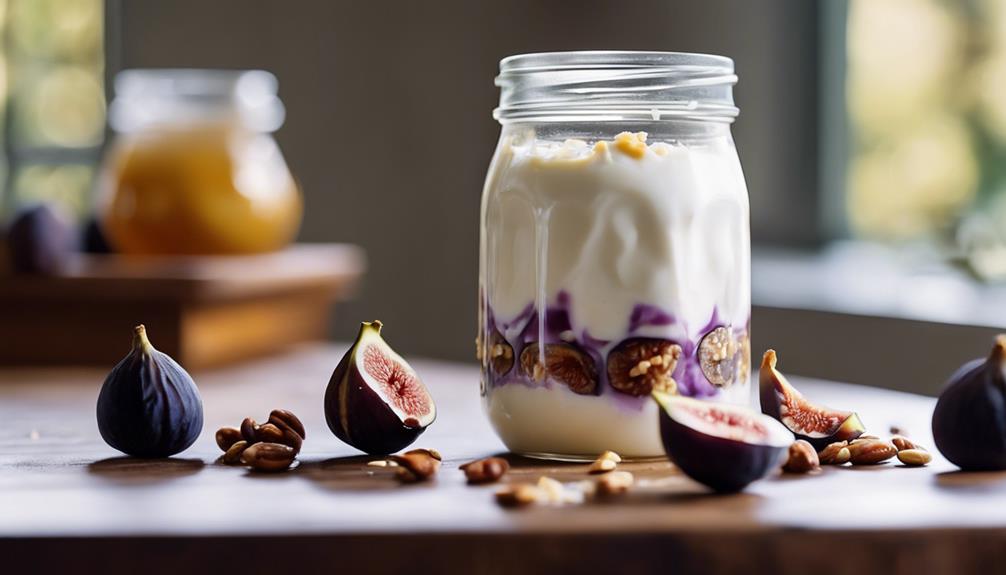
Reflecting on the overall experience, you may find that the journey to creating Sous Vide Greek Yogurt With Honeyed Figs was a delightful culinary adventure. Your reflections on this culinary experience might reveal the satisfaction of transforming simple ingredients into a gourmet treat. From the initial steps of preparing the yogurt to the careful process of infusing the figs with honey, each stage likely brought a sense of accomplishment and anticipation of the final result.
As you ponder your culinary experiences with this recipe, you might appreciate the precision and science behind sous vide cooking. The controlled temperature and time settings guarantee a consistent outcome, allowing you to achieve the perfect texture and flavor in your yogurt. Additionally, the combination of creamy yogurt and sweet, caramelized figs showcases the harmonious blend of contrasting tastes and textures.
Frequently Asked Questions
Can I Use Regular Yogurt Instead of Greek Yogurt for This Recipe?
Yes, you can use regular yogurt as an alternative for Greek yogurt in this recipe. The texture may vary slightly, but overall, the dish will still turn out delicious. Consider adjusting the sweetness levels to suit your taste.
How Long Does It Take for the Figs to Be Honeyed?
To honey figs for best flavor profile, let them ripen fully beforehand. Apply honey generously and let them sit for at least 1-2 hours. This preservation method enhances sweetness and texture, making them a perfect pairing for your dish.
Can I Substitute Figs With Other Fruits in This Recipe?
Yes, you can substitute figs with various fruits in the recipe. Experiment with berries, peaches, or apples for unique flavors. Try ingredient alternatives to create diverse versions. Have fun exploring fruit substitutions and recipe variations!
What's the Best Way to Store Leftover Honeyed Figs?
To properly store leftover honeyed figs for extended freshness, place them in an airtight container in the refrigerator. This method helps maintain the flavor and texture of the figs, ensuring their longevity and allowing you to enjoy them for longer.
How Can I Adjust the Sweetness Level of the Yogurt?
To adjust the sweetness of your yogurt, simply mix in more honey or a sweetener of your choice until the taste is just right. Experiment with different flavors like vanilla extract or cinnamon for delicious variations.
Conclusion
To sum up, mastering the art of making sous vide Greek yogurt with honeyed figs requires attention to traditional techniques and key ingredients.
By understanding the yogurt-making process in Greece and the importance of straining, you can create creamy, tangy yogurt with a touch of sweetness.
Experiment with different flavor combinations to elevate your yogurt creations and enjoy the delicious results of this ancient culinary tradition.
